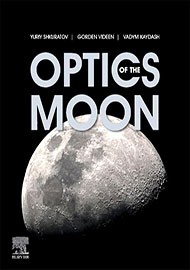
This is a “big” book, in actual size, but also in terms of technical depth, quality of writing and even maybe as a geopolitical statement. All of the authors, two in Ukraine and one in the United States, hold senior positions in astronomy-related organizations and have an asteroid named after them. Probably due to the references to the war in Ukraine, the publisher felt the need to claim a neutral position with respect to the territorial disputes or jurisdictional claims made in the book (the first book this reviewer has seen to include such a disclaimer).
The physics and math in the book are challenging. As expected, given the pedigree of the authors and the nature of the subject, the book is heavily mathematical, and one might view the equations as having truly astronomical complexity. This is not a book about the poetry and beauty of the moon (although the authors appreciate both, refer to them, and include poems and jokes to lighten the reading). The focus is on the use of light to understand the physics of the moon, via spectroscopy, polarimetry and photometry.
Despite the encyclopedic size, this book is not a full historical review of existing papers, but, in the authors’ own description, biased by the personal research experience and expertise of the authors (a “Moonograph,” as they affectionately call it). The authors recognize that there is some overlap among chapters, which were written somewhat independently, and to some extent the overlap is deliberately left in.
The book is adorned with many graphs and photos in black and white, with a smaller number in color. There is an extensive set of references at the end of each chapter, in addition to a short list of recommended literature at the end of preface, including a couple of books in Russian. An extensive index, including references to figures and tables, is helpful for the printed version, although the online book reviewed has its own search capabilities.
This book is probably too “big” to serve as a textbook, in particular because it lacks problems and exercises. But, clearly intended as a reference, it is loaded with technical and historical information, is fun to read, and shows the moon in an entirely new light (pun intended).
Review by Bogdan Hoanca, University of Alaska Anchorage, USA.
The opinions expressed in the book review section are those of the reviewer and do not necessarily reflect those of OPN or its publisher, Optica
